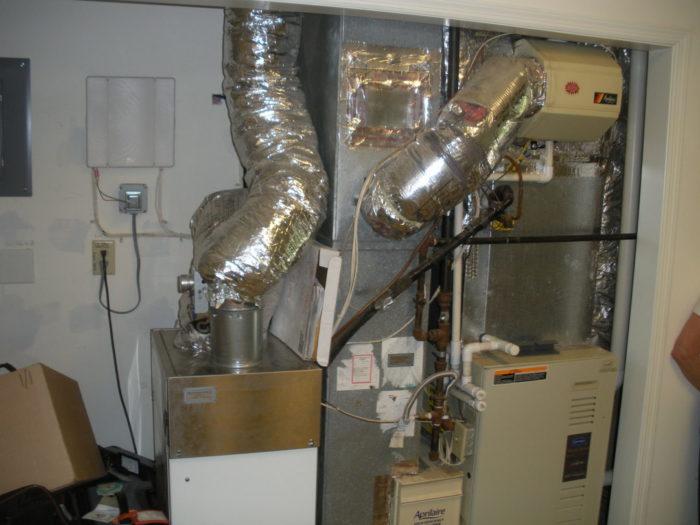One of the side benefits of being on a long bus trip like the one to the Koetter millwork plant is that people talk quite a bit. Not being particularly shy, I talked a lot about high-performance homes and green building when given the opportunity. Conversations often started out with the “it’s so expensive” or “it’s too hard” sort of comments, which provided me the opportunity to dispel those myths — which I believe I did with occasional success. As a result of these discussions, Ken Lynch, a local architect on the trip, recently called me to consult on a renovation and addition he was starting. Many years ago, I was the contractor on a major renovation and addition project he designed that turned out very nicely, but this was the first opportunity I had had to work with him since then.
Teaching and learning
My role as a consultant on single-family projects usually begins with a walk-through of an existing house, or a review of plans for a new one, followed by a list of recommended changes and improvements to make the project — for lack of a better word — “greener.” In the case of this project, I looked at building envelope issues, combustion safety, HVAC design and installation, and moisture management. As is typical of most homes that have been built or renovated in the past 20 or so years, little thought had been put into these very important issues. I always see these projects as teaching opportunities, and, thankfully, in most cases the professionals involved appreciate the information they get from me and learn something in the process.
Problems I uncovered
I walked through the house with the owner and architect before renovations were scheduled to start. The contractor was not available; he has received my list of recommendations, and I expect to get some questions about them before or during the renovation process. The biggest problem I identified in the house is the HVAC system. A sealed-combustion furnace in the garage has minimal duct sealing, particularly where ducts are connected to the return plenum. Sometimes I wonder how people actually survive conditions like this, since it is likely that carbon monoxide is very effectively distributed through the house when cars are idling and the air handler is operating.
In addition, an atmospherically vented water heater is located immediately next to the furnace. Although I didn’t perform a backdraft potential test, likely it does not vent properly all the time. Finally, the ceiling above the furnace is wide open to a duct chase that goes all the way into the attic, creating an excellent (and unwanted) thermal chimney from the bottom to the top of the house. One nice feature is a high-quality central dehumidifer installed next to the furnace. As far as I can tell, though, it is installed to supply only one room that previously had some moisture issues, which were partially corrected through some high-quality crawl space sealing work.
Some other problems I noticed included marginal attic floor and kneewall insulation, poorly installed floor insulation over the crawlspace, recessed lights installed in insulated rooflines, and a huge, barely insulated skylight facing south that practically cooks the kitchen in the afternoon.
The prescription
As this is not a complete gut renovation, they will not be able to improve all the building envelope issues, but there is much they can do that will make the home much more efficient and healthy. My report to the owner and architect broke down into three priority levels.
My highest priorities were improving the building envelope, HVAC, and bulk moisture management — to me the most important issues in most projects. Although I am becoming more cautious about spray foam due to potential health issues, I still recommend it for many renovations as it is about the only way to create an effective thermal envelope in existing buildings. I suggested that they apply spray foam to all accessible rooflines to create conditioned attic areas. An alternative would be to upgrade kneewall and ceiling insulation and air sealing, but this would leave ducts in unconditioned attics and would be much more difficult (and probably more expensive) than the spray-foam alternative.
At the bottom of the house, I suggested that they improve the air sealing and insulation on the underside of the crawl space or, alternatively, insulate and air seal the crawl space walls as well as close off the existing chase to the attic.
My recommendations for the HVAC system included applying full mastic seal on all ductwork, installing dedicated returns in all major rooms, incorporating the central dehumidifier into the HVAC to serve the entire house, performing an accurate load calculation on the house to make sure that the existing equipment is properly sized, and providing appropriate whole-house ventilation. Other suggestions included removing as many recessed lights in the building envelope as possible, careful air sealing at walls, ceilings, and floors, and careful weather barrier and flashing installation at all new and renovated exterior walls.
So, what will they do?
I understand that there was a pre-construction meeting recently to discuss my suggestions with the contractor — who, incidentally, is an old competitor of mine from many years ago. I have not yet heard from anyone regarding the project, but I expect that there will be questions and some additional consulting work headed my way as the project progresses. It felt good to have had enough of an impact on the architect that he called me in to provide advice on the project before construction began. I was able to point out some critical issues that they otherwise would not have noticed, and I believe that I taught everyone a little bit about building science.
While the team certainly has a long way to go to become experts in analyzing a home and determining the most appropriate improvements, I hope that I have sparked some interest in building performance that they will take to the next job. Not everyone can be a building science expert — and I’m not sure I want them all to be, at least not until I am ready to retire — but the more building professionals know about whole-house systems, the closer we will get to universally high-performance homes.
Here’s to hoping that more people like Ken Lynch call me in to help them make their projects perform better and continue to raise the performance level of renovations and new homes alike.
Weekly Newsletter
Get building science and energy efficiency advice, plus special offers, in your inbox.
















0 Comments
Log in or create an account to post a comment.
Sign up Log in